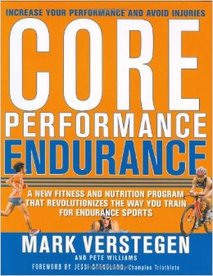 Core Performance Endurance Mark Verstegen and Pete Williams New York, USA Rodale Inc, 2007 238 pages Core Performance Endurance, co-authored by one of the pioneers of "functional training", Mark Verstegen, is a book written primarily for the endurance demographic with an objective of improving performance and avoiding injuries. The foundation of this text lies in Verstegen's first book, Core Performance, but expands further based on the consideration of the typical high-volume and -intensity training programs of endurance athletes. Core Performance Endurance is divided into four parts; 1) The Core Endurance Mindset; 2) Core Endurance Movement; 3) Core Endurance Nutrition; and 4) The Core Endurance Workout. The Core Endurance Mindset lays the foundation for this book through a brief explanation of the importance of elasticity and tissue tolerance within the body and an interactive, reader-engaging biomechanical self-assessment. Core Endurance Movement builds upon this new "mindset" through an explanation of Pillar Strength, an introduction of "power endurance" (which I essentially interpret as "efficiency"), a look into TRUE energetics, and the importance of regenerating the body. While I respect the content of this text in its entirety, the heart and soul of Core Performance Endurance lies in this section (part 2) through its potential to stimulate thought in the "experienced" athlete and pull him or her out of his/her comfort zone and into a new, more effective training mentality. While the majority of Verstegen and Williams' nutritional advice can be found in their book Core Performance Essentials, part 3 of this book, Core Endurance Nutrition addresses strategies that endurance athletes can utilize in their quests for performance. Specifically, Verstegen and Williams address the high importance of carbohydrates and protein, as well as the role of specific fats and nutritional supplements in athletes, but perhaps more importantly, they address meal timing as it pertains to improved performance. Examples of specific meals and food sources are included here. Finally, part 4 introduces The Core Endurance Workout, a regime built around power, strength, and regeneration. Unless the athlete is a coached professional or has experience in the field of contemporary strength and conditioning, it is unlikely he or she will be familiar with this approach to training. The workout contained within looks nothing like your conventional gym workout (bodybuilding OR team sport), nor does it resemble a program commonly seen in rehabilitation settings. The exercises incorporated are detailed and geared toward improving both biomechanical efficiency AND performance. Progressions are included and transition the athlete from day one, straight through to race day. While the world of sports performance and injury prevention continually evolve with contemporary research, Core Performance Endurance indeed provides a valuable educational resource to athletes of all levels and abilities. For the coach or sport medicine professional working with this demographic, this text also provides excellent insight into the role movement efficiency plays on various aspects of running, triathlon, and other similar sporting endeavors.
0 Comments
Leave a Reply. |
